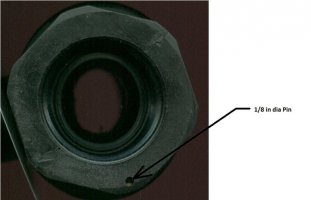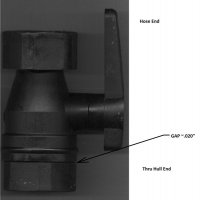Marelon Ball Valves
Something amazing today. While removing 2 Marelon Valves in our 1986 E32-3 they BOTH EASILY UNSCREWED! The new Marelon valves say to use teflon tape for thread sealant but before I do that I would like to know what Ericson used. Whatever it was held leak tight for 23 years, did not harden and as I mentioned allowed easy removal. It looked and felt kind of gooey and brownish in color.
In the last 2 days I have learned some valuable lessons about Forespar Marelon Ball Valves which Ericson used extensively for Thru Hull Valves in our E32-3. The valves I learned my lessons on are the 1 1/4 inch model MF850 PN 905103 shown in the picture. First off the reason for this exercise was I had two of these valves which stuck and I could not open or close them. On one, I broke the handle trying and, the other I salvaged (before I broke a handle). I will list the lessons learned below.
LESSON 1 - New MF850 valves have a 1/8 in dia pin installed from the thru hull end to prevent that end from turning relative to the main body, the hose end, of the valve. See the picture. The older valves in our 1986 E32-3 do not have a pin and the valves can be disassembled which is both good and bad. This is good because you can disassemble the valve for through cleaning and O-ring replacement if so motivated (there is 3 O-rings, handle, body and ball). It is bad because the valve will appear to freeze up if the the two halves are screwed together too tightly. They need to be assemebled carefully.
LESSON 2 - My problem was caused when I replaced the hose fittings in two of my valves. When I installed the new hose barbs I caused the valve body to tighten closing the gap, see picture, thereby freezing the valve ball. No open or close anymore. These things can be tricky. Now, newer model valves with a pin do not have this problem.
LESSON 3 - The valves I removed were probably over 20 years old. I expected them to be fouled with barnacles or whatever grows in Puget Sound, and I expected that to be the cause of freezeing up. Wrong. They looked in good condition, were easy to remove and had I been smarter they would still be in service. The reason they were frozen was over tightening - my fault. So the lesson for a frozen "old" Marelon Valve is first loosen the valve body about a 1/4 turn. Do this be holding the thru hull end of the valve then unscrewing the hose end. But important - this can only be done if the valve does not have a pin, see Lesson 1. If it has a pin the valve is frozen for some other reason than over tightening and other web sites have schemes for helping that.
Something amazing today. While removing 2 Marelon Valves in our 1986 E32-3 they BOTH EASILY UNSCREWED! The new Marelon valves say to use teflon tape for thread sealant but before I do that I would like to know what Ericson used. Whatever it was held leak tight for 23 years, did not harden and as I mentioned allowed easy removal. It looked and felt kind of gooey and brownish in color.
In the last 2 days I have learned some valuable lessons about Forespar Marelon Ball Valves which Ericson used extensively for Thru Hull Valves in our E32-3. The valves I learned my lessons on are the 1 1/4 inch model MF850 PN 905103 shown in the picture. First off the reason for this exercise was I had two of these valves which stuck and I could not open or close them. On one, I broke the handle trying and, the other I salvaged (before I broke a handle). I will list the lessons learned below.
LESSON 1 - New MF850 valves have a 1/8 in dia pin installed from the thru hull end to prevent that end from turning relative to the main body, the hose end, of the valve. See the picture. The older valves in our 1986 E32-3 do not have a pin and the valves can be disassembled which is both good and bad. This is good because you can disassemble the valve for through cleaning and O-ring replacement if so motivated (there is 3 O-rings, handle, body and ball). It is bad because the valve will appear to freeze up if the the two halves are screwed together too tightly. They need to be assemebled carefully.
LESSON 2 - My problem was caused when I replaced the hose fittings in two of my valves. When I installed the new hose barbs I caused the valve body to tighten closing the gap, see picture, thereby freezing the valve ball. No open or close anymore. These things can be tricky. Now, newer model valves with a pin do not have this problem.
LESSON 3 - The valves I removed were probably over 20 years old. I expected them to be fouled with barnacles or whatever grows in Puget Sound, and I expected that to be the cause of freezeing up. Wrong. They looked in good condition, were easy to remove and had I been smarter they would still be in service. The reason they were frozen was over tightening - my fault. So the lesson for a frozen "old" Marelon Valve is first loosen the valve body about a 1/4 turn. Do this be holding the thru hull end of the valve then unscrewing the hose end. But important - this can only be done if the valve does not have a pin, see Lesson 1. If it has a pin the valve is frozen for some other reason than over tightening and other web sites have schemes for helping that.
Attachments
Last edited:


